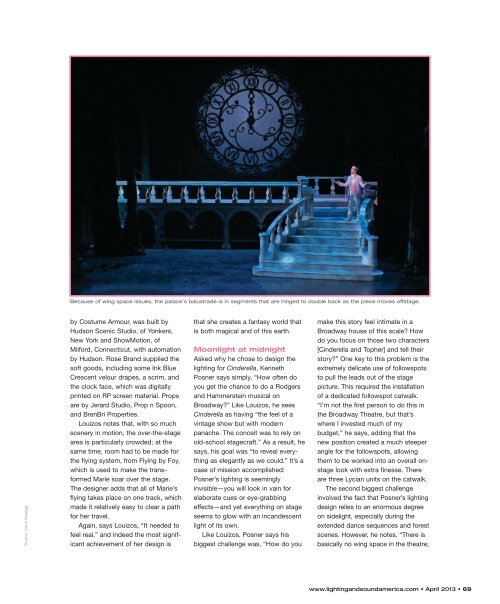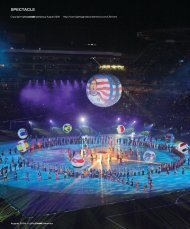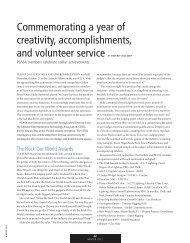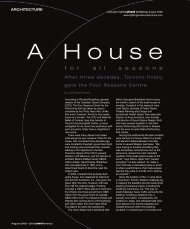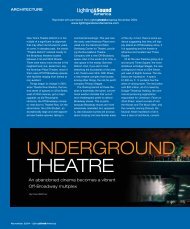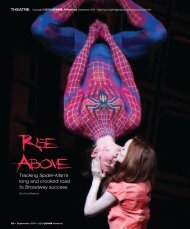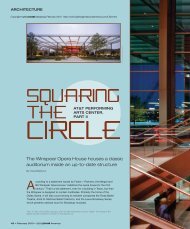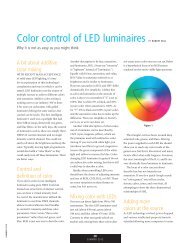Cinderella - Lighting & Sound America
Cinderella - Lighting & Sound America
Cinderella - Lighting & Sound America
You also want an ePaper? Increase the reach of your titles
YUMPU automatically turns print PDFs into web optimized ePapers that Google loves.
Because of wing space issues, the palace’s balustrade is in segments that are hinged to double back as the piece moves offstage.<br />
Photos: Carol Rosegg<br />
by Costume Armour, was built by<br />
Hudson Scenic Studio, of Yonkers,<br />
New York and ShowMotion, of<br />
Milford, Connecticut, with automation<br />
by Hudson. Rose Brand supplied the<br />
soft goods, including some Ink Blue<br />
Crescent velour drapes, a scrim, and<br />
the clock face, which was digitally<br />
printed on RP screen material. Props<br />
are by Jerard Studio, Prop n Spoon,<br />
and BrenBri Properties.<br />
Louizos notes that, with so much<br />
scenery in motion, the over-the-stage<br />
area is particularly crowded; at the<br />
same time, room had to be made for<br />
the flying system, from Flying by Foy,<br />
which is used to make the transformed<br />
Marie soar over the stage.<br />
The designer adds that all of Marie’s<br />
flying takes place on one track, which<br />
made it relatively easy to clear a path<br />
for her travel.<br />
Again, says Louizos, “It needed to<br />
feel real,” and indeed the most significant<br />
achievement of her design is<br />
that she creates a fantasy world that<br />
is both magical and of this earth.<br />
Moonlight at midnight<br />
Asked why he chose to design the<br />
lighting for <strong>Cinderella</strong>, Kenneth<br />
Posner says simply, “How often do<br />
you get the chance to do a Rodgers<br />
and Hammerstein musical on<br />
Broadway” Like Louizos, he sees<br />
<strong>Cinderella</strong> as having “the feel of a<br />
vintage show but with modern<br />
panache. The conceit was to rely on<br />
old-school stagecraft.” As a result, he<br />
says, his goal was “to reveal everything<br />
as elegantly as we could.” It’s a<br />
case of mission accomplished:<br />
Posner’s lighting is seemingly<br />
invisible—you will look in vain for<br />
elaborate cues or eye-grabbing<br />
effects—and yet everything on stage<br />
seems to glow with an incandescent<br />
light of its own.<br />
Like Louizos, Posner says his<br />
biggest challenge was, “How do you<br />
make this story feel intimate in a<br />
Broadway house of this scale How<br />
do you focus on those two characters<br />
[<strong>Cinderella</strong> and Topher] and tell their<br />
story” One key to this problem is the<br />
extremely delicate use of followspots<br />
to pull the leads out of the stage<br />
picture. This required the installation<br />
of a dedicated followspot catwalk.<br />
“I’m not the first person to do this in<br />
the Broadway Theatre, but that’s<br />
where I invested much of my<br />
budget,” he says, adding that the<br />
new position created a much steeper<br />
angle for the followspots, allowing<br />
them to be worked into an overall onstage<br />
look with extra finesse. There<br />
are three Lycian units on the catwalk.<br />
The second biggest challenge<br />
involved the fact that Posner’s lighting<br />
design relies to an enormous degree<br />
on sidelight, especially during the<br />
extended dance sequences and forest<br />
scenes. However, he notes, “There is<br />
basically no wing space in the theatre;<br />
www.lightingandsoundamerica.com • April 2013 • 69


